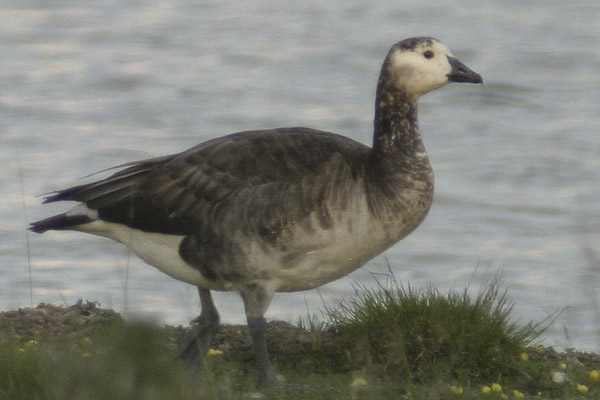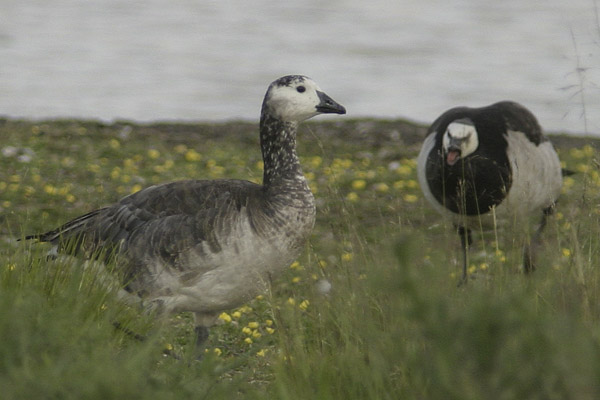

The dark bill and black feet point towards a branta. The shape of the cheek patch suggests a Barnacle.
I this bird a leucistic Barnacle Goose? Could be, but several features point towards a hybrid origin and do not fit those of a Barnacle Goose color form.
1. The grey areas on the mantle have a darker, browner background
2. The bill is larger than Barnacles
3. The flanks are darker than in Barnacle
4. Contrast between the dark breast and pale belly is very diffuse
5. Wings are quite short and do not extend beyond the tail.
6. Dark thigh patch on the rear flanks behind the feet
All these fit to an Anser being another parent. Based on the wing length the Greater White-fronted Goose appears most likely. The bird was about the same size than a barnacle points towards a Greater White-fronted Goose. Both of these field marks as well as the relatively large bill appear to indicate against a Lesser White-fronted Goose.
Note that there were hybrid Greylag x White-fronted Goose in the Turku area only two years earlier. and a hybrid Canada x White-fronted Goose one year earlier.
Mustat nokka ja koivet viittavat toisen emon olleen Branta-laji. Poskitäplän muoto viittaa valkoposkihanheen.
Voisko tämä olla leukistinen valkoposki? Periaatteessa ehkä, mutta tässä linnussa seuraavat valkoposkeen sopimattomat seikat viittaavat kuitenkin siihen että kyseessä olisi risteymä.
1. Selässä valkoposken vaalean harmaissa alueiden kohdalla selvää tummaa
ruskehtavaa väritystä.
2. Nokka on isompi kuin valkoposkella.
3. Kupeet ovat tummemmat kuin valkoposkella.
4. Tumman rinnan ja vaalean vatsan välillä varin diffuusi raja. Valkoposkella olisi jyrkkä.
5. Siivet ovat lyhyet, eivätkä ulotu pyrstön yli.
6. Tumma reisilaikku kupeiden takaosassa
Kaikki nämä kohdat viittaavat siihen että toisena emona olisi jokin Anser-laji.
Siiven pituuden perusteella tundrahanhi on ilmeisin. Nokka on myös suurehko,
sopien paremmin tundrahanheen, kuin kiljuhanheen, mikä olisi voinut olla toinen
risteymävaihtoehto.
Huomaa, että 2 vuotta aiemmin, vuonna 2002 risteytyivät Varsinais-Suomessa
, meri- ja tundrahanhi , ja sitten vuonna 2003
and tundra ja kanadanhanhi.


Last update: April 6, 2006